Three years ago I wrote a post called The Seventh Samurai, which was motivated by the fact that I had looked at the list of the 100 top juniors in the world and saw seven Americans on the list. One of the names, Akshat Chandra, was unfamiliar to me then (though quite familiar now), and I wrote a post about him.
Back then I called this a “Golden Era” of American chess. Well, in the three years since then, the era has become even more golden! Despite the “graduation” of people like Daniel Naroditsky to the adult ranks, America has more juniors than ever on the top-100 list: eleven! To put this in context, we are seriously catching up to Russia, which has fifteen players on the list, and we are far ahead of China, which has only four (though it does have the #1, Wei Yi).
Here is the honor roll. How many of them have you heard of?
5. Jeffery Xiong; 6. Samuel Sevian; 22. Ruifeng Li; 34. Awonder Liang; 53. Michael Brown; 69. Akshat Chandra; 74. John Burke; 77. Andrew Tang; 85. Daniel Gurevich; 86. Kayden Troff; 94. Luke Harmon-Vellotti.
For me, there were three unfamiliar names on the list: Michael Brown, Andrew Tang, and Daniel Gurevich. But this is simply because I am not paying enough attention! It turns out that every one of these eleven youngsters played in either the Chicago Open or the World Open, both held within the past month. Here are their results:
Xiong — 3rd in the World Open (!!)
Sevian — 1st in the Chicago Open (!!!), 40th in World (must have partied too much)
Li — 10th in Chicago, 20th in World
Liang — 8th in Chicago
Brown — 4th in Chicago, 26th in World
Chandra — 76th in Chicago
Burke — 27th in World
Tang — 42nd in World
Gurevich — 9th in Chicago
Troff — 31st in Chicago (but oh, by the way, he is currently leading the U.S. Junior Closed Championship, with one round to go)
Harmon-Vellotti — 15th in Chicago, 141st in World.
This list of accomplishments leaves my jaw hanging open. Every single one of these kids, except maybe Chandra, has had at least one outstanding result this summer.
Because Michael Brown is the highest-rated of the “unfamiliar” names, let me write a little bit more about him. He’s from southern California, 18 years old, an International Master with (I believe) one GM norm, goes to Brigham Young University and is an Eagle Scout. In an interview with NBC Los Angeles, he said that he had one of his “most memorable games” at the Chicago Open, in which he won from a “crazy position” against a Grandmaster. At one point he turned down the GM’s draw offer. I think that this must be the game. Not only did he beat a GM, he won as Black in an opening where the GM is one of the world’s leading experts.
Boris Avrukh — Michael Brown, Chicago Open, Round 7
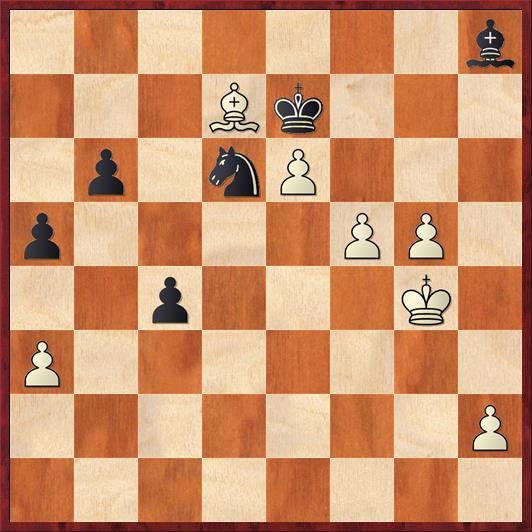 Position after 46. f5. Black to move.
Position after 46. f5. Black to move.
FEN: 7b/3Bk3/1p1nP3/p4PP1/2p3K1/P7/7P/8 b – – 0 46
Brief summary of the game so far: Avrukh has written the most definitive book on the Catalan Opening (1. d4 Nf6 2. c4 e6 3. g3 d5), so it stands to reason that Brown played 3. … Bb4+ instead, going into the Bogo-Indian. However, I suspect that Avrukh knows a great deal about that opening too. In the middle game Avrukh sacrificed a piece for three pawns, but I doubt that he got as much play as he expected. Brown was able to win back one of the pawns; nevertheless, White’s pawn mass is pretty intimidating. What would you do here as Black?
If you’re like me, you’ll say 46. … c3, and the computer agrees with both of us. However, Black does have to be careful. After 47. f6+ it is essential to give up the bishop for the two pawns: 47. … Bxf6! 48. gf+ Kxf6 49. Ba4 Nc4, with threats of both … Ne3+ and … Nxa3. According to the computer, Black is easily winning. But over the board, I can completely understand why Brown would have some doubts. With Black’s knight way over on the queenside, the king will have to stay close enough to the kingside to keep the h-pawn in check, and can he really win that way? With the three connected passed pawns, probably he can.
But Brown decides, if I have to give up a piece anyway, why not do it right now? In fact his decision was absolutely correct. He is winning the opposite-color bishop endgame, and if he really saw his way to the conclusion, it is one of the most amazing endgame combinations I’ve seen.
46. … Nxf5!!? 47. Kxf5 c3 48. Ba4 b5! 49. Bc2 …
Of course, White can’t take, because his bishop has to constantly keep an eye on the c2 square. Now do you see the right followup?
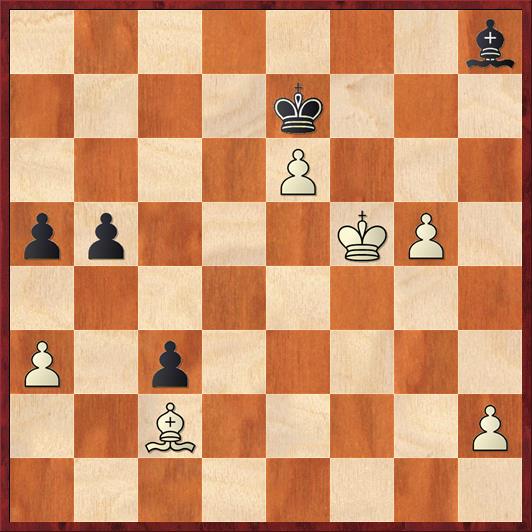 Position after 49. Bc2. Black to move.
Position after 49. Bc2. Black to move.
FEN: 7b/4k3/4P3/pp3KP1/8/P1p5/2B4P/8 b – – 0 49
I think this position is a litmus test of the difference between a master and an amateur. Most amateurs, say below 1800, would (I think) play 49. … b4 without thinking, and the game would be a draw. Masters play the correct move automatically. Even so, I think Brown’s next move deserves an exclamation point.
49. … a4!
A common motif when advancing pawns against a bishop. It’s actually better for them to be separated than connected, because it’s harder for the bishop to stop them both.
50. Ke4 b4
White can’t take either pawn; either 51. Bxa4? ba or 51. ab? a3 would allow Black to achieve his objective. But White can calmly bring his king to the defense.
51. Kd3! b3 52. Bd1 …
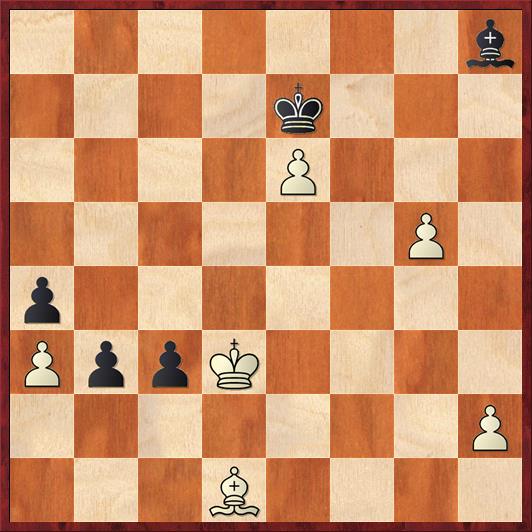 Position after 52. Bd1. Black to move.
Position after 52. Bd1. Black to move.
FEN: 7b/4k3/4P3/6P1/p7/PppK4/7P/3B4 b – – 0 52
I would bet anything that this is the position where Avrukh offered a draw. The grandmaster may have even thought that it was a draw, or maybe he saw how Black wins but didn’t believe that his young opponent would be able to figure it out. Either way, tremendous credit goes to Brown for looking deeper and not taking the offer. And if he actually saw this position back on move 46 and worked out how Black wins … all I can say is wow.
52. … Be5!
The exclamation point is mostly for not playing 52. … c2??, which throws away the win. After 53. Bxc2 bc 54. Kxc2, even though Black can win the a3 pawn, he loses the a4 pawn in the process. The move 52. … Kxe6 also wins, but 52. … Be5! is a move of great acuity. Black places White’s pieces in zugzwang — if either the king or bishop moves, Black wins without difficulty after 53. … c2. Therefore White is reduced to pawn moves.
53. h4 Kxe6 54. g6 Kf6 55. h5 Kg5 56. Ke3 …
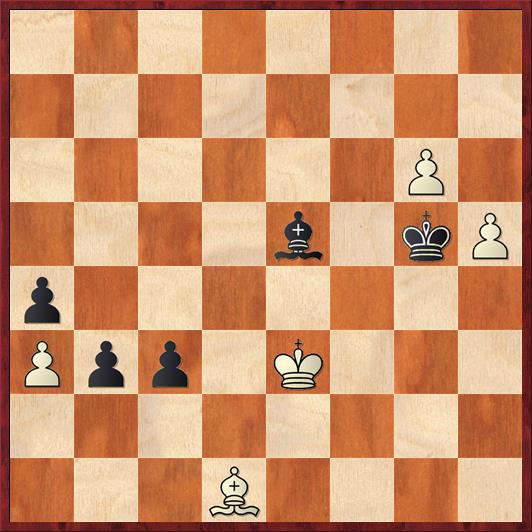 Position after 56. Ke3. Black to move.
Position after 56. Ke3. Black to move.
FEN: 8/8/6P1/4b1kP/p7/Ppp1K3/8/3B4 b – – 0 56
Or perhaps this is where Avrukh offered the draw? If so, he was fully justified in doing so. White realizes he is no longer in zugzwang. If Black plays 56. … c2? now, White pulls out an amazing draw. To wit, 56. … c2? 57. Bxc2 bc 58. Kd2 Kh6! (… Kh5? is an easy draw) 59. Kxc2 Bd6 60. Kc3 Bxa3 61. Kc4 Be7 (or f8 if you want, it doesn’t matter) 62. Kc3 and the position is drawn! (See figure below.)
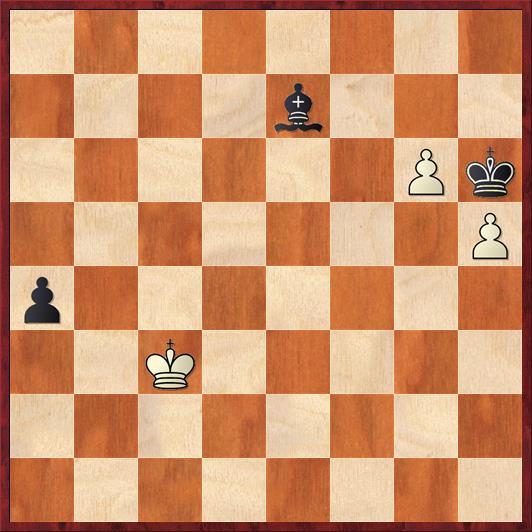 Position after 62. Kc3 (analysis). Draw!
Position after 62. Kc3 (analysis). Draw!
FEN: 8/4b3/6Pk/7P/p7/2K5/8/8 b – – 0 62
Even though Black has gotten himself a passed a-pawn, and it has the “right color” queening square, he still cannot win. If the king ever takes on h5 or attempts to come to the queenside, White will be able to deflect Black’s bishop away from the defense of the a-pawn.
I don’t know about you, but if I were in the position of diagram four and realized that White has a miracle draw after 56. … c2, I would be pretty darned upset. I might even take the draw offer. But Brown doesn’t lose his cool and finds an elegant, appropriate way to finish the game in two moves. (Go back up to previous diagram.)
56. … Kh6!! 57. Kd3 Bd4!!
The last position absolutely deserves a diagram.
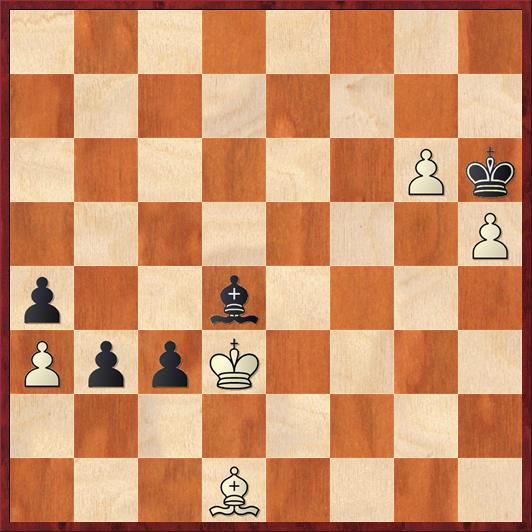 Position after 57. … Bd4. White to move.
Position after 57. … Bd4. White to move.
FEN: 8/8/6Pk/7P/p2b4/PppK4/8/3B4 w – – 0 58
Now it really and truly is zugzwang! If the king takes the bishop (or moves anywhere on the fourth rank), then 58. … c2 wins. If the bishop moves, then 58. … c2 wins. White’s king can’t go to e3; that was the point of 57. … Bd4. And finally, there is a beautiful interference theme — if 58. Ke2 the king gets in the way of the bishop, and Black can simply play 58. … Kxh5. After he rounds up the g- and h-pawns, the king can stroll over to the queenside, shoulder White’s king out of the way, and promote the c-pawn.
If anyone can think of a better endgame by an 18-year-old against a grandmaster, I’d like to see it! Truly a wonderful accomplishment by Brown.



{ 1 comment… read it below or add one }
Nice ending, thanks for sharing! It was interesting to see Brown give up the piece for only one pawn, when he easily could’ve gotten two. But, his king could as easily stop both the g- and h-pawns as just the h-pawn, and so the way he did so had its advantages.
I was familiar with Michael Brown somewhat, having watched him present a game in a free analysis session with John Watson a few years ago at the Dreaming King Open down in San Diego. Sharp kid, I thought, not knowing who he was until I watched him battling Sevillano in the next round… I also watched him play a totally crazy game vs De Guzman at the US Amateur Team West down in Irvine in recent years. Both times I was impressed with his fighting spirit and overall demeanor.
And as a bit of a trivial aside, I was watching the local So. Cal news a month or so ago. They were showing college graduation activities (this being the season and all), and this whiz kid pops up on the screen. You know, way to young to be getting a college degree in some crazy techie double major, maths being one of the two for sure. And the kid (18? 19?) has a job waiting for him at Google…
Well, it was Luke Harmon-Vellotti! I thought I recognized the name, so I took a picture of the screen and verified it.
And so the chess world loses another top player, but no doubt this is the right decision for him. Google has a lot more riches to spread around than does Caissa…